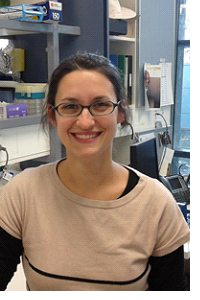




MAUD BERNOUX


maud.bernoux@csiro.au





Plant immune receptors function
Abstract
Plant disease is a major threat to agriculture worldwide, and breeding disease resistance (R) genes into crops is currently a key strategy for plant protection. The majority of plant resistance genes encode immune receptors that belong to a nucleotide binding-leucine rich repeat (NB-LRR) family. These receptors can recognize specific pathogen proteins or effectors, and then activate defense responses. However, the mechanisms controlling NB-LRRs activation and defense signaling are poorly understood.
In the flax plant system, the L6 immune receptor is aToll/interleukin-1 receptor (TIR) domain containing NB-LRR, which confers resistance to the flax rust fungus (Melampsora lini) containing the AvrL567 effector. Using a structure-function analysis approach, we previously demonstrated that L6 activation depends on the dimerization of its signalling TIR domain (Bernoux et al., 2011). Using similar approaches, we later identified and characterised a different TIR dimerization interface in the Arabidopsis paired immune receptor RPS4/RRS1, which is required for the function of this paired receptor but differs from the previously described L6 TIR dimerization interface (Williams et al., 2014). Recently, the crystal structure of the Arabidopsis SNC1 NB-LRR TIR domain revealed the presence of two dimerization interfaces (L6-like, and RPS4/RRS1-like). Functional studies suggest that both interfaces are required for plant TIR signalling function. To further define our current model for plant immune receptor activation, we have investigated several other questions such as: i) what are the mechanisms that control the receptor transition from inactive to active states upon effector recognition and ii) where/how the early signalling steps following TIR dimerization are triggered.
References:
Williams SJ*, Kee Hoon Sohn KH*, Wan L*, Bernoux M*, Sarris PF, Segonzac C, Ve T, Ma Y, Saucet SB, Ericsson DJ, Casey LW, Lonhienne T, Winzor DJ, Zhang X, Coerdt A, Parker JE, Dodds PN, Kobe B, Jones JD (2014) Structural Basis for Assembly and Function of a Heterodimeric Plant Immune Receptor. Science, Apr 18;344(6181):299-303.
*joint first author
June 2013-present, ARC Research Fellow (DECRA), CSIRO Agriculture, Canberra
May 2008-June 2013, Postdoctoral Fellow, CSIRO Agriculture, Canberra
April 2008, PhD, Laboratory of plant-microorganism interaction, INRA-CNRS/ University of Toulouse, France
Research Fields and Interests:
My research interest is to improve our understanding of plant disease resistance. In particular, my research combines structural and functional analyses of plant immune receptors to investigate how they function and activate the plant immune system in response to pathogen perception. This area is fundamental for designing and engineering new and more effective resistance genes and/or improving strategies to protect agricultural crops from destructive diseases.
Selected Publications:
Césari S, Bernoux M, Moncuquet P, Kroj T, Dodds PN. (2014) A novel conserved mechanism for plant NLR protein pairs: the ‘integrated decoy’ hypothesis. Front Plant Sci. Nov 25;5:606
Césari S, Kanzaki H, Fujiwara T, Bernoux M, Chalvon V, Kawano Y, Shimamoto K, Dodds P, Terauchi R, Kroj T. (2014) The NB-LRR proteins RGA4 and RGA5 interact functionally and physically to confer disease. EMBO J. Sep 1;33(17):1941-59
Williams SJ*, Kee Hoon Sohn KH*, Wan L*, Bernoux M*, Sarris PF, Segonzac C, Ve T, Ma Y, Saucet SB, Ericsson DJ, Casey LW, Lonhienne T, Winzor DJ, Zhang X, Coerdt A, Parker JE, Dodds PN, Kobe B, Jones JD (2014) Structural Basis for Assembly and Function of a Heterodimeric Plant Immune Receptor. Science, Apr 18;344(6181):299-303.
*joint first author
Ravensdale M, Bernoux M, Ve T, Kobe B, Thrall PH, Ellis JG, Dodds PN (2012). Intramolecular interaction influences binding of the flax L5 and L6 resistance proteins to their AvrL567 ligands. PLoS Pathogens, 8(11):e1003004
Takemoto D, Rafiqi M, Hurley U, Lawrence G, Bernoux M, Hardham AR, Ellis J, Dodds P, Jones D. (2012) N-terminal motifs in some plant disease resistance proteins function in membrane attachment and contribute to disease resistance. Mol Plant Microbe Interactions, 25(3): 379–392
Bernoux M, Ellis JG, Dodds PN. (2011a) New insights in plant immunity signaling activation. Curr Opin Plant Biol, Oct, 14: 512–518.
Bernoux M, Ve T, Williams S, Warren C, Hatters D, Ellis JG, Kobe B, Dodds PN. (2011) Structural and functional analysis of a plant resistance protein TIR domain reveals interfaces for self-association, signaling and autoregulation. Cell Host & Microbe, Mar, 9: 200-11
Tasset C, Bernoux M, Jauneau A, Pouzet , Briere C, Kieffer-jaquinod S, Rivas S, Marco Y, Deslandes L. (2010) Autoacetylation of the Ralstonia solanacearum effector PopP2 targets a lysine residue essential for RRS1-R-mediated immunity in Arabidopsis. PLoS Pathogens, 6: 1-14.
Bernoux M, Timmers T, Jauneau A, Briere C, de Wit PJ, Marco Y, Deslandes L. (2008) RD19, an Arabidopsis Cysteine protease required for RRS1-R-mediated resistance, is relocalized to the nucleus by the Ralstonia solanacearum PopP2 effector. Plant Cell, 20: 2252-64.